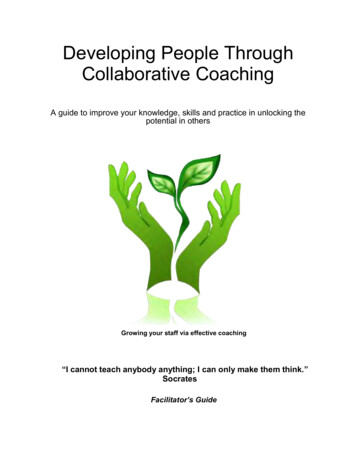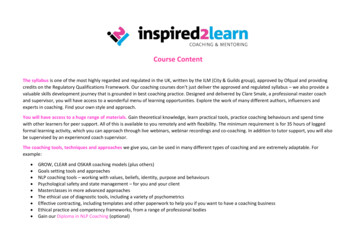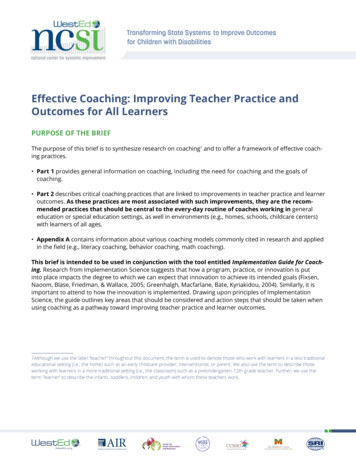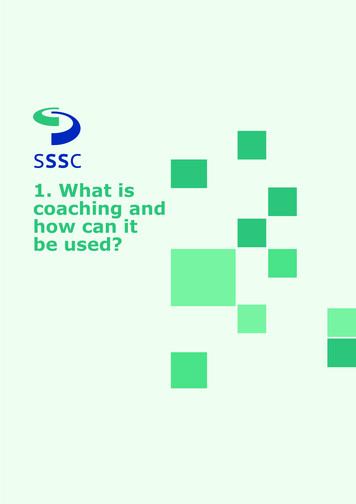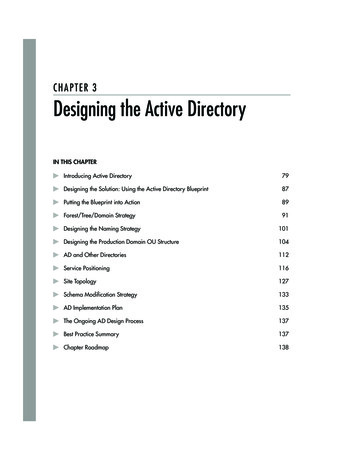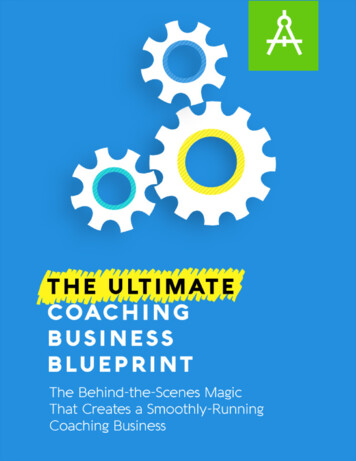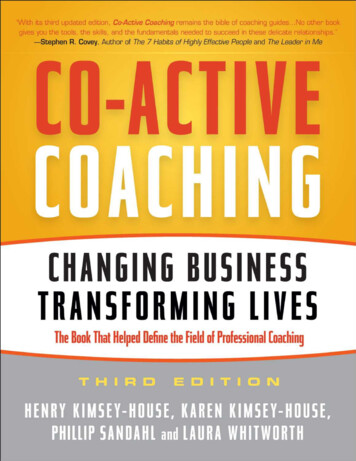
Transcription
Praise for Co-Active Coaching, 3rd Edition“With its third updated edition, Co-Active Coaching remainsthe bible of coaching guides. Written with a powerful,distinctive approach, no other book gives you the tools, theskills, and the fundamentals needed to succeed in these delicaterelationships.”—Stephen R. Covey, Author, The 7 Habits of HighlyEffective People and The Leader in Me“In Co-Active Coaching, the dynamic Kimsey-House duo,along with Phillip Sandahl, have elevated coaching from aninstructional tool to an art form! Picasso would be proud.Seldom have I seen such a clear road map for how to‘overcome actions that sabotage desires, plans and dreams.’Collaboration, cooperation, coalition — all necessarycomponents of a successful working relationship. The KimseyHouses and Sandahl prove to us that Co-Active Coaching isvital as well. As a gym coach leads his trainee to a higher stateof physical health and wellbeing, Co-Active Coaching providesbusiness coaches a toolkit for helping their clients achieveprofessional and personal success. Co-Active Coaching shouldbe required reading for every manager or employee who wantsto succeed in the workplace.”—Marshall Goldsmith, Million-Selling Author, NewYork Times Bestsellers MOJO and What Got You HereWon’t Get You There“Co-Active Coaching exudes the catalytic power to transform
your organization and your life. Read it, savor it, and practice itto become a purpose-filled leader of life!”—Kevin Cashman, Best-Selling Author, Leadershipfrom the Inside Out and Awakening the Leader Within“I applaud the new edition of this definitive text ontransformational coaching. The authors and the visionarynetwork they lead provide an effective methodology to workwith change at personal and organizational levels. This is amust-read for professionals who value the process ofdiscovery, awareness, and choice that empowers people to findtheir own inner wisdom and to act in service to make a betterworld for all.”—Lynne Twist, Author, The Soul of Money, Founder,Soul of Money Institute, and Co-Founder, ThePachamama Alliance“When designing our ICF ACTP coach certification program,we never considered any textbook other than Co-ActiveCoaching. This is the best, most comprehensive book forteaching the relevant skills of coaching. It should be requiredreading for all coach-specific training programs in anyenvironment (profit, non-profit, executive, teams, etc.). Withthe enhancements made in the third edition, we look forward toincorporating this edition into our required reading list.”—Donna Billings, PCC and Co-Founder, ProfessionalCoach Certification Program, Duquesne UniversitySchool of Leadership and Professional Advancement
“Co-Active Coaching insightfully reveals how to unlock aperson’s potential and enlighten their past, present, and future.It’s a must-read for all self-empowered senior executives.”—Michael Cheah, Former President, Xian-JanssenPharmaceutical, China (A Johnson & Johnson Group ofCompanies)“Transformational change — in ourselves or in the teams,organizations, and companies we lead — is ultimately all aboutrelationships. The third edition of Co-Active Coaching, by theeloquent and compassionate founders of The Coaches TrainingInstitute, will give you the tools, skills, strategies, and ethicalframeworks to achieve the powerful goals of this work:changing lives and changing the world.”—Celeste Schenck, President, American University ofParis“Coaching basics are an essential skill set for any manager orleader who is interested in developing other people, so I usethis material in most of the MBA courses I teach. Without fail,it engages the hearts and minds of people who care aboutacquiring meaningful and effective skills they can immediatelyput to use.”—Heidi Brooks, PhD, Director, Yale School ofManagement Mentoring Program, Lecturer, Yale Schoolof Management, and Clinical Assistant Professor, YaleSchool of Medicine, Department of Psychiatry
CO-ACTIVE COACHINGChanging Business, Transforming LivesTHIRD EDITIONHenry Kimsey-HouseKaren Kimsey-HousePhillip SandahlandLaura Whitworth
This edition first published by Nicholas Brealey Publishing, in2011.20 Park Plaza, Suite 1115ABoston, MA 02116 USATel: 617-523-3801Fax: 617-523-37083-5 Spafield Street, ClerkenwellLondon, EC1R4QB, UKTel: 44-(0)-207-239-0360Fax: 44-(0)-207-239-0370www.nicholasbrealey.com 2011 Henry Kimsey-House, Karen Kimsey-House & PhillipSandahlAll rights reserved. No part of this publication may bereproduced in any manner whatsoever without writtenpermission from the publisher, except in the case of briefquotations embodied in critical articles or reviews.Printed in the United States of America15 14 13 12 111 2 3 4 5ISBN: 978-1-85788-567-5Library of Congress Cataloging-in-Publication DataKimsey-House, Henry.Co-active coaching : changing business, transforming lives /Henry Kimsey-House, Karen Kimsey-House, Phillip Sandahl.— 3rd ed.p. cm.
Rev. ed. of: Co-active coaching : new skills for coachingpeople toward success in work and life / Laura Whitworth . [etal.]. 2nd ed. c2007.Includes index.ISBN 978-1-85788-567-51. Self-actualization (Psychology) 2. Mentoring. 3.Motivation (Psychology) 4. Success—Psychological aspects. I.Kimsey-House, Henry, 1953– II. Sandahl, Phillip, 1948– III.Co-active coaching. IV. Title.BF637.S4W484 2011658.3’124—dc232011023281
ContentsA Special Dedication: For Laura WhitworthPreface to the Third EditionAcknowledgmentsIntroductionPART1 Co-Active Coaching Fundamentals1: The Co-Active Coaching Model2: The Co-Active Coaching RelationshipPART2 Co-Active Coaching Contexts3: Listening4: Intuition5: Curiosity6: Forward and Deepen7: Self-ManagementPART3 Co-Active Coaching Principles and Practices8: Fulfillment9: Balance10: Process11: Putting It All TogetherGlossaryAbout the AuthorsIndex
A Special Dedication: For Laura WhitworthCreator of the Co-Active model with Henry Kimsey-House andKaren Kimsey-House, a recognized leader in the developmentof the coaching profession, and coauthor of the first twoeditions of this book.Laura Whitworth died February 28, 2007, after a courageousbattle with cancer. You could not find two words in the Englishlanguage more appropriate for her: courageous battle. What shebelieved in, she fought for. If you were ever her client, orparticipated in a program Laura led, you know. She wasfighting for you.She was a visionary and a pioneer; she was a compelling force.Her relentless commitment to life fully lived is a model and aninspiration. That life force named Laura Whitworth created theseeds from which the coaching tree has grown; she didn’t do italone, of course, but her tenacity certainly made sure it grew.She founded The Coaches Training Institute with Henry andKaren Kimsey-House and created the Co-Active coachingmodel and training with them. Together they created anenormously powerful leadership program, a transformative lifeexperience for participants. Just ask them. She wasinstrumental in the development and growth of the coachingprofession and was one of the first to call the work she did“coaching.”We would say we miss her—and naturally we do. But herpresence, her spirit, are so alive in the work today that we feel
her with us still.We dedicate this third edition to Laura and to the courageousbattle she stood for: a life fully lived. In every moment we aregiven. With every breath we breathe.
Preface to the Third EditionThere are two fundamental reasons for this third edition of CoActive Coaching.Reason one: coaching keeps changing, evolving. Theapplication of coaching skills and competencies has expandedfar beyond the profession itself. Today the interest in coachingas a skill set and communication form is everywhere: inbusiness, in schools, in government, in families. At the sametime, the profession of coaching continues to evolve and growas well, expanding in numbers and geography, in a wideningarray of distinct niches and in its own understanding of whatcoaching is and how it works.Reason two: Co-Active coaching as a model and methodcontinues to grow and evolve. We continue to expand our reachas trainers of coaches, and new people around the world reachout to find us. The more we teach, the more we learn about ourown way of coaching, and the more our students teach us aboutthe transformative power of this work. We have more claritytoday about the nature of Co-Active coaching as a uniquecontribution to the field, and we have more clarity about whatgives this approach the impact we see and results in the positivefeedback we receive.Over the years, this book has served as the learningfoundation for thousands of coaches and thousands more whosimply wanted to know how to bring a coach-like conversationto important relationships at work or at home. This book is nowthe standard text for coaching education in many colleges and
universities, business schools, and coaching programs aroundthe world. We are humbled, frankly, by the scale of that picture,and feel a responsibility to keep pace with the growth andchange. This third edition is still grounded in the basics: theCo-Active coaching model and the skills and tools for effectivecoaching that support it. Where we have revised the languageand examples, our intent has been to broaden the reach of thecontent, to be more inclusive, and to provide a wider breadth ofapplications. Where we provide new insight, we want to shareour growing awareness of our stand for transformational changeat the heart of Co-Active coaching.The Evolving, Growing World of CoachingIn the years since the first edition was published, coaching as afield of interest has spread around the world. From its origins inNorth America and Europe, it is now a familiar subject on everycontinent, and the numbers continue to grow exponentially. It isas if there were an unmet need in the world, in every corner,and that unmet need is hungry for what coaching offers. Theworld is pulling coaching. The numbers and the geographicreach are impressive, but it is the underlying pull itself that hasour attention. Change is a way of life and it is accelerating.Coaching is a methodology that allows us to work with change,on a personal level, on an organizational level, on a relationshiplevel. As people become more aware of coaching as a way tofacilitate purposeful change, the application of coachingfundamentals continues to evolve and expand.The growth is not just geographic; coaching continues tobecome more diverse in its reach as coaches specialize in a
wide variety of demographic and interest-related niches. Nearlyevery age, occupation, and personal passion has a coach waitingto answer the call.In the corporate world, coaching was once the exclusive perkof key executives and rising stars, but it is now a standardcomponent in the organizational toolkit to help employees,managers, supervisors, and executives in their personaldevelopment and their contribution to the organization’ssuccess. In recent years, employee engagement and culturechange have emerged as core initiatives for organizations, andcoaching plays a critical role in that change process.Organizations have learned that highly motivated and fulfilledemployees produce high-performance results. In fact, manyorganizations now offer in-house coach training to acceleratethe introduction of the coaching mindset and coaching skills.With increasing pressure to do more with less, organizationshave dramatically expanded their emphasis on the “team” as themeans to improve productivity. More and more, they are alsolearning the benefits of team coaching: training teams and teamleaders in the skills and competencies needed in today’s morecollaborative world. Coaching is a key resource for optimizingpotential for both individual achievement and for highperforming, sustainable team excellence.Even the definition of “coach” is expanding. Today, a widevariety of professional service providers include coaching orcoaching skills in their service offerings. They recognize thatessential change takes time and focused attention. It’s whycoaching is so valuable to any change initiative.Coaching also has a growing role in the world of leadershipdevelopment. With a high percentage of senior executives and
top managers set to retire in the next ten years, successionplanning and leadership development have becomeorganizational imperatives. With the changing nature oforganizations, the emphasis on leadership development focusesmore and more on emotional intelligence and the associatedpeople skills of leaders. And that is where coaching and acoaching skill set for leaders becomes invaluable. The bestleaders in the next generation are forming today, with coachingas an asset in their development.In the first edition, we talked about Co-Active coaching asnot only a set of professional skills but a unique way ofcommunicating. That awareness is even more apparent todaywhen we see this “coach approach” adapted to so many settingsbeyond the work of professional coaches. For example, we seeteachers using coaching skills and a coaching style when theseare called for. We see managers, parents, customer servicerepresentatives, and health-care workers using coaching skillsand a coach approach. The qualities that make a coachinginteraction effective are valuable in many settings.The Toolkit and Keeping Pace with ChangeOn the subject of keeping pace with change, one of the mostpopular sections of the book has been moved to the web. TheCoach’s Toolkit took up a large section of the first edition; itwas reproduced on a CD for the second edition to make it easierto print examples. For the third edition, we have moved thetoolkit to the web so that documents can be easily updated andnew documents can be added. To view the Coach’s Toolkit,simply go to http://www.coactive.com/toolkit.
Welcome to the Third EditionOver the years we have seen Co-Active coaching embraced bymany different cultures. It is amazing to see the impact of thiswork in so many different languages and with so many differentlocal expressions. It reminds us that at the deepest level, thework we do is human: helping individuals and teams (microcommunities, really) fulfill their dreams, live out their values,and achieve the results that matter. We are reminded over andover again that the Co-Active coaching model crosses all of theusual boundaries: geographic, cultural, and demographic. Welive in exciting and changing times, in which coaching can bean incredibly valuable asset. We are delighted to share what wehave learned over the last few years by bringing you this thirdedition.It is enormously gratifying to see that the Co-Activecoaching model continues to be strong, durable, and adaptableto the growing and evolving world of coaching.Henry and Karen Kimsey-House, Phillip Sandahl, and with theindomitable and ever-present spirit of Laura Whitworth Spring2011
AcknowledgmentsWe owe an enormous debt of gratitude to so many people whohave supported, encouraged, and championed this work—fartoo many to name—some we have never met. They representall of the coaches and clients/coachees who have embarked ona coaching journey; their lives and work are a livingacknowledgment and a powerful motivation to keep thismaterial current and meaningful.Coaching training played an enormous role in spreading thepower and possibility of coaching as a profession and becameits own learning laboratory for what works in coaching. Thefaculty and staff of The Coaches Training Institute have been atthe forefront of the mission to prepare new coaches, maintainhigh professional standards, and keep the Co-Active methodthriving. Their commitment to the essence and the particularshas helped us continuously refine what we present, and theircontribution shows in this third edition.We have seen coaching spread around the globe in the yearssince the first edition was published. Clearly there is a hungerin the world that is pulling coaching into organizations,relationships, and individual lives—something that transcendsall of the usual boundaries. We want to especially acknowledgethose courageous pioneers at the forefront of the global efforts.It would not happen without the vision and initiative ofdetermined people willing to take on the challenge of languageand culture for the sake of coaching.To the thousands of coaching students we have trained, to
our own clients, and, yes, our own coaches, we are thankfulbeyond words. And finally, to the clients who are and havealways been our most important teachers, this acknowledgmentis for you. You are the reason we do this work.Henry and Karen Kimsey-HousePhillip Sandahl
IntroductionIn today’s world, coaching is both a growing professionworldwide and a growing communication style adopted bybusiness, government, and non-profit leaders, teachers,counselors, parents, and others. This book describes aparticular approach to coaching and the coaching relationshipthat we call “Co-Active coaching” because it involves theactive and collaborative participation of both the coach and thecoachee or client. The underlying beliefs of Co-Activecoaching make it both powerful and adaptable.The Co-Active coaching model is a proven approach basedon many years of experience working with clients and coachesworldwide. This book describes the model in detail, defines theskills and techniques of Co-Active coaching, and offers samplesof coaching conversations as well as practical exercises thatwill enhance your understanding.The Co-Active coaching model was the starting point and isstill at the core of the training we do through The CoachesTraining Institute (CTI). CTI was founded in 1992 by LauraWhitworth and Henry and Karen Kimsey-House. Today, CTI isthe largest in-person coach training organization in the world,delivering courses in North America, Europe, the Middle East,and Asia. CTI offers a comprehensive training program forcoaches that includes a highly regarded certification program;CTI also offers a unique leadership development program,courses in coaching mastery and business development, and adiverse online network through which coaches may engage in
special-interest dialogue. Because of our pioneering work in thefield of coaching, we have been instrumental in thedevelopment of the core principles and skills associated withcoaching and continue to be strong contributors and a visionaryforce for the profession.Getting to the CoreThis book, however, is not just about skills and a description ofthe model. It is about the nature of a coaching relationship—specifically, a Co-Active relationship. We look at the nature ofa Co-Active conversation and at what makes it so differentfrom other conversations—whether the conversation is betweena professional coach and coachee, or between a senior managerand that person’s direct report. The heart of that conversation isthe same in the Co-Active model. This book gets to the core ofwhat makes a Co-Active conversation different from othereveryday conversations.What is different about a Co-Active coaching conversation?In our view, coaching is not about solving problems, althoughproblems will be solved. It is not primarily about improvingperformance, attaining goals, or achieving results, although allof that will certainly happen over time in an effective CoActive coaching relationship. We believe that coaching ischiefly about discovery, awareness, and choice. It is a way ofeffectively empowering people to find their own answers,encouraging and supporting them on the path as they continueto make important life-giving and life-changing choices.Co-Active coaching is a form of conversation with inherentground rules regarding certain qualities that must be present:
respect, openness, compassion, empathy, and a rigorouscommitment to speaking the truth. There are certainassumptions underlying the conversation as well. We assumestrength and capability, not weakness, helplessness, ordependence. We assume a deep desire to give the best andachieve potential. A coaching conversation has certain beliefsbuilt into it: that every situation has possibilities and thatpeople really do have the power of choice in their lives.In our view, Co-Active coaching is a way of being in arelationship and being in a conversation that might be unique inhuman history. It is a way of communicating that shifts thefocal point of the conversation from rank or content to a deeperlevel of human connection. This way of communicating isfinding root not only in formal coaching relationships, but inthe workplace as a leadership style, and in teams and familiesas well. It works partly because it taps into a human need forcollaborative, Co-Active communication that is so differentfrom the usual authoritarian, superior–inferior communicationexperience. This naturally arising expression of peer-to-peercommunication—which is more about possibilities created thanpositions claimed—is part of an evolving human consciousness.We believe Co-Active conversations are both an example ofthis shift in human consciousness and an instrument to create it.This unique style of Co-Active communication is visible in avariety of ways. You can see it in the way a coach listens, notonly to the words but also to what is behind the words, and evento the spaces between the words. The person who listens as acoach listens is someone who tunes in to the nuances of voice,emotion, and energy—someone who is intent on receivingeverything that person communicates. The coach or the person
in the coach role is someone who listens to the very best inothers, even when they can’t hear it in themselves.A coach is someone who cares that people create what theysay they want and that they follow through when they choose.The coach is there to hold people accountable and keep themmoving forward toward their dreams and goals. Ultimately, thecoach is there to help people live lives of meaning and purpose.In our view, one of the most essential qualities of a coach,and something clients can count on in a Co-Active coachingrelationship, is truthfulness. A coach is someone who willabsolutely tell the truth—the truth about where clients arestrong, for example, and where they hold back and give up,deny, or rationalize.With this book, you will learn new ways to work with others:how to discover and promote your client’s mission, purpose,and specific agenda. You’ll find effective ways to rigorouslyhold others to account. You’ll learn the Co-Active coachingapproach to values, goal-setting, life balance, and selfmanagement.You’ll also learn coaching strategies for addressing the selflimiting behavior that often shows up strongest just whenpeople need the courage to take risks for the sake of change.These proven strategies help clients stay on track and overcomeactions that sabotage desires, plans, and dreams.This book emphasizes information and exercises forprofessional coaches, yet the skills and insights it offers can beapplied in almost any relationship—at work, with family andfriends, on teams, in volunteer and community settings—because coaching skills and the nature of the relationship are
not limited to professional coaching sessions. We recognizethat the essence of coaching is now an adapted communicationstyle growing beyond the skill set of professional coaches.That’s one of the main reasons for this enhanced third edition.How the Book Is StructuredPart 1 presents an overview of the Co-Active coaching model.The first chapter starts with the four cornerstones. They formthe foundation on which the model is built. Together they forman interrelated net in which powerful conversations can occur.We go on to build the model with the introduction of the fivecontexts of Co-Active coaching: listening, intuition, curiosity,forwarding action and deepening learning, and selfmanagement. The chapter also describes the three principles—fulfillment, balance, and process—that together form theclient’s focus at the heart of the model. Part 1 also explains howto design an effective working relationship between coach andcoachee/client. What we call the “designed alliance” providesclarity and empowers the coaching relationship.Part 2 describes each of the five contexts in detail andpresents descriptions and examples of the coaching skills inaction. Here we provide sample coaching conversations as wellas exercises that bring the skills to life.Part 3 covers the three core principles: how to coach theclient’s fulfillment, balance, and process. In the last chapter, wedescribe the integration of these three principles into theartistry of coaching.In summary, this book offers a comprehensive approach tounderstanding the nature of an effective Co-Active coaching
relationship and the skills needed to support it. The bookprovides a systematic structure reinforced with real-lifeexamples and practical exercises for developing your coachingabilities. It is a book for those who want to expand theirknowledge and develop their capacities as professional coachesand those who wish simply to add a coaching approach toimportant conversations using the unique model we call CoActive coaching.
PART 1Co-Active Coaching FundamentalsFrom day one, coaching focuses on the coachee/client.1 Peopleparticipate in or seek out coaching because they want things tobe different. They are looking for change or they haveimportant goals to reach. People come to coaching for lots ofindividual reasons. They are motivated to achieve specificgoals: to write a book, to start a business, to have a healthierbody. They come to coaching in order to be more effective ormore satisfied at work or to develop new skills to help navigatelife’s changes. Sometimes people want more from life—morepeace of mind, more security, more impact in their work. Andsometimes they want less—less confusion, less stress, lessfinancial pressure. In general, they come to coaching becausethey want a better quality of life—more fulfillment, betterbalance—or a different process for accomplishing their lifedesires. Whatever the individual reason, it all starts with astirring of motivation within the coachee.Part 1 explains what the coach brings to this interaction andshows what the process looks like from a Co-Active coachingperspective. In this part of the book, we outline the elementsand convey a sense of how they fit together in a comprehensivemodel. In later chapters, we expand on these major componentsto provide more depth and offer examples from coachingconversations.
CHAPTER 1The Co-Active Coaching ModelThe term “Co-Active” refers to the fundamental nature of acoaching relationship in which the coach and coachee areactive collaborators. In Co-Active coaching, this is arelationship—in fact an alliance—between two equals for thepurpose of meeting the coachee’s needs.Four CornerstonesThe four cornerstones form a container that holds the Co-Activeconversation. In fact, the cornerstones make it possible to havea truly Co-Active conversation. In order for engaged andempowered relationship to exist—the “co” in Co-Active—andin order for life-giving action on the part of the coachee tomanifest, these four form a necessary structure.People Are Naturally Creative, Resourceful, and WholeWe start with this assertion: people are, by their very nature,creative, resourceful and whole. They are capable: capable offinding answers; capable of choosing; capable of taking action;capable of recovering when things don’t go as planned; and,especially, capable of learning. This capacity is wired into allhuman beings no matter their circumstances. In the Co-Activemodel it is more than a belief—it is a stand we take.The alternative is a belief that people are fragile and dependent.With that belief, the coach’s job would be to guide the coacheeto the safest possible outcome. You can feel the difference.
When we take a stand for other people’s natural creativity andresourcefulness, we become champions on their behalf, notworried hand-holders. As coaches, when we assumeresourcefulness and creativity, we become curious, open topossibilities, discovering with the coachee, not dictating. Weexpect to be amazed.The key here is “naturally.” Yes, of course, there are timeswhen the circumstances feel overwhelming, when even themost resilient human being feels the mountain is too high, theroad to cross too wide, the effort simply not in his power.Circumstances and that inner sabotaging voice that says, “Whybother?” or “You don’t have what it takes,” can leave anyonefeeling less than creative, resourceful, and whole. On thosedays, more than on any others, it is our place as coaches to seethe true, natural self who was and is still capable. We remindour coachees of their own inner light and help them find itagain—because it is there. Naturally.Focus on the Whole PersonFor most people who want to be helpful, and for most newcoaches or people in a coaching role, the question that’s oftenforemost on their minds is this: “What’s the problem to solve?”It’s a question that comes from the best of intentions: a desireto understand and provide valuable assistance so that a problemcan be solved. But when a coach is sitting across from acoachee (even by telephone), the coach is not sitting acrossfrom a problem to be solved; the coach is sitting across from aperson. This person does have a problem to solve—a change tomake, a dream to fulfill, a task to accomplish, a goal to reach.All of that is true. But this person is more than the problem at
hand—or the goal, the dream, the task. This is a whole person:heart, mind, body, and spirit. And the issue, whatever it is, isnot neatly isolated. It is inexorably entwined in the coachee’swhole life.Maybe “focus” is a little misleading in the title of thiscornerstone. We are certainly not talking about a hard, tight,concentrated focus on the whole person. It is more of a broadattention, a soft focus that includes the whole person and thewhole life, and involves liste
universities, business schools, and coaching programs around the world. We are humbled, frankly, by the scale of that picture, and feel a responsibility to keep pace with the growth and change. This third edition is still grounded in the basics: the Co-Active coaching model and the skills and tools
